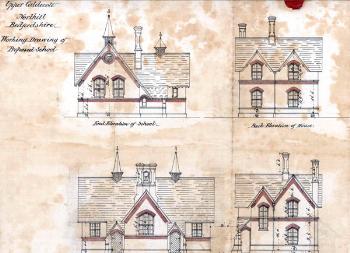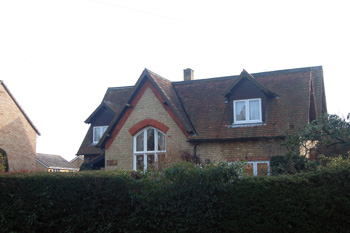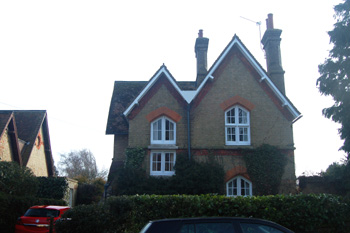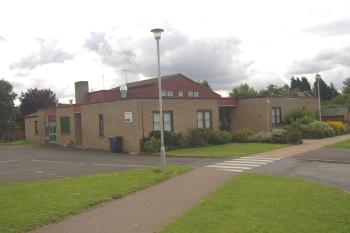Caldecote School

Elevations of Caldecote School [AD3865/31/3]
The school in Upper Caldecote was created as a NationalSchool in 1860, notice of its opening being in the Bedfordshire Mercury of 17 November that year. In other words, it subscribed to the principles of the National Society, who had contributed a grant to its building, which were to teach poor children in accordance with the religious principles of the Church of England. The school was built, as was the church, at the urgings of the indefatigable Rector of Northill, Rev.Arthur S.Pott. The school plans are held by Bedfordshire & Luton Archives & Records Service [AD3865/31] and logbooks run from 1862 to 1969 [SDNorthill(Caldecote)1-3]
The first Education Act was passed in 1870 (more correctly it was known as the Elementary Education Act). It was a milestone in the provision of education in Britain demonstrating central government's unequivocal support for education of all classes across the country. It also sought to secularise education by allowing the creation of School Boards. These were groups of representatives, elected by the local ratepayers and the Board had the powers to raise funds to form a local rate to support local education, build and run schools, pay the fees of the poorest children, make local school attendance compulsory between the ages of 5 and 13 and could even support local church schools, though in practice they replaced them, turning them into Board run schools (known as Board Schools). Naturally, and luckily for local historians, the Act required a questionnaire of local schools in 1870. The return for Northill notes Upper Caldecote National School as accommodating 107 children.
A land mark Education Act was passed in 1902, coming into effect in 1903. It disbanded the School Boards and gave day to day running of education to newly formed Local Education Authorities, usually the county council, as in Bedfordshire. The old Board Schools thus became Council Schools whilst the old National, British and other non-Board schools became known as Public Elementary Schools. CaldecoteNationalSchool duly became CaldecotePublicElementary School.
Bedfordshire & Luton Archives & Records Service has a scrapbook of cuttings of visits made to most Bedfordshire Schools by School Inspectors for a period from just before the First World War through the inter-war years [E/IN1/1]. The first visit recorded in the scrapbook was in 1908, when the inspector noted: "This school has been visited many times since last reported upon and at every visit has been found in a thoroughly excellent state of efficiency". However, as for the buildings: "The ventilation of the rooms is defective and the warming arrangements in the main room are not very satisfactory". In 1911 whilst the junior children were satisfactory: "In the Infants Division the order, the attainments of the scholars, and the methods of teaching all leave much to be desired and a marked general improvement will be expected next year". Furthermore: "The removal of the cumbrous gallery in the Infants room would be a great and indeed necessary improvement". Most Victorian infants rooms in schools seem to have been built with a gallery and it is normal for the inspector to comment that these should be removed.
The next visit was in October 1914, three months into the First World War, when average attendance was 96: "The tone and discipline of this School are praiseworthy and creditable work is done in all the classes. A pleasing feature of the school is the interest the Head Teacher [Mrs. E. Wilson] takes in the welfare of the older girls and the steps which are taken to prepare them to take their place in the world when schooldays are over". Heating in the main room was still inadequate and it was also noted that the numbers in the infants' class were getting too large for their accommodation.
The inspection of 1922 dealt wholly with premises and found that the offices [i.e. the toilets] urgently required lime washing, there was no lavatory basin in the school "This provision is all the more necessary as several children stay to mid-day dinner"! The walls of the school also needed repainting, preferably in a lighter colour to make the ambience less dark. The school was also very short of books. In 1923, when average attendance was 108, the Inspector noted of the functioning of the school: "This school is carefully taught, and the children are thoroughly well behaved. There are some backward children in Standard II, but they were backward when they came up from the Infants' Division at the end of a period during which the school had been understaffed; they are well taught now". This understaffing was, no doubt, due to the First World War with male teachers in the armed forces and women who might have become teachers doing war work.
In 1925 the Inspector once again had cause to complain about the buildings: "The offices in this school are cesspits of type: they are roofed with corrugated iron of a steep pitch off which water pours after rain on children approaching the offices: they should be reconstructed as Water Closets….The boys' cloakroom is a passage porch with a badly fitting door under which a draught comes into the colder end of the main room: the girls' and infants' cloakroom is very small, very dark, and not well ventilated: the doors open inwards and face each other at a very short distance and shut with dangerous violence in windy weather. There are two classes in each room and the lighting is too strong in the teacher's eyes in the main room. The temperature in the main room, especially at one end, is unsatisfactory. The school is very full but extension is possible". The next year the inspector noted: "The present Head Master has done well in the comparatively short time since his appointment, when he found ….weak attainments in the lower part of the school…The Head Master has improved matters in the top division considerably".
In 1927 the school was valued under the 1925 Rating Valuation Act. The valuer noted [DV1/C/4] that the school was built of brick and tile and had 2 classrooms, 2 porches used as cloak rooms, a boys' lavatory, a girls' lavatory and a coal house and could accommodate 111 scholars. He further noted: "County Council do inside repairs & pay staff". He noted that the School House was occupied by C.H.Penson and was built of brick and tile and was detached from the school. The building containeda hall, living room, pantry and kitchen, 3 bedrooms, outside earth closet, coal house, water laid on being, all told "v.good".
By the time of the last inspection in the scrapbook, 1934, the Head Master had give way to a Head Mistress who had been: "absent through illness for fairly prolonged periods during the past two years. the state of the school in these circumstances is creditable to her and to the Supply Teachers who have taken her place when she has been away". The inspector concluded: "It is a pleasant school to visit".

The Old School March 2010
The third of the great Education Acts was that of 1944 which established the principle of County Primary Schools for children up to the age of 11, at which time they took an examination to determine the nature of the secondary school they would attend until they were 15, the most academically able going to grammar schools, the rest to secondary or secondary modern schools. The act also created two types of successor to the public elementary schools - the Voluntary Aided and Voluntary Controlled schools. Voluntary Aided schools are those in which the Local Education Authority funds the school but the governing body is independent. Voluntary Controlled schools own their own buildings whilst the staff are employed directly by the governors. At this time Caldecote became a VoluntaryControlledCountyPrimary School. By the 1860s the school buildings were a hundred years old and no longer convenient. A new site was acquired in manor Place and the infants moved into the new purpose built classroom in May 1965. It is clear from the log book [SDNorthill(Caldecote)3] that the older children moved into the school at some later date but, unfortunately, it is not specified in records held by Bedfordshire and Luton Archives and Records Service, nor is the date at which the old school was given up. Entries in the log book show that the school was still on two sites at least as late as July 1966. Today [2010] both the old school and the old school house are private residences.

The Old School House - 4 Biggleswade Road March 2010
In the 1970s Bedfordshire County Council introduced comprehensive education, doing away with the 11+ examination and grammar schools and introducing a tier of school between the old County Primary and County Secondary Schools. Thus Lower Schools now taught children aged 4 to 9, Middle Schools from 9 to 13 and Upper Schools from 13 onwards. Caldecote duly became a Voluntary Controlled Lower School.
 Caldecote Lower School July 2007
Caldecote Lower School July 2007